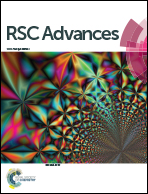Electrodeposited Pd/graphene/ZnO/nickel foam electrode for the hydrogen evolution reaction
Abstract
Efficient electrocatalysts are crucial to water splitting for renewable energy generation. In this work, electrocatalytic hydrogen evolution from Pd nanoparticle-modified graphene nanosheets loaded on ZnO nanowires on nickel foam was studied in an alkaline electrolyte. The high electron mobility stems from the cylindrical ZnO nanowires and the rough surface on the graphene/ZnO nanowires increases the specific surface area and electrical conductivity. The catalytic activity arising from adsorption and desorption of intermediate hydrogen atoms by Pd nanoparticles improves the hydrogen evolution reaction efficiency. As a hydrogen evolution reaction (HER) catalyst, the Pd/graphene/ZnO/Ni foam (Pd/G/ZnO/NF) nanocomposite exhibits good stability and superior electrocatalytic activity. Linear sweep voltammetry (LSV) revealed an overpotential of −31 mV and Tafel slope of 46.5 mV dec−1 in 1 M KOH. The economical, high-performance, and environmentally friendly materials have excellent prospects in hydrogen storage and hydrogen production.



 Please wait while we load your content...
Please wait while we load your content...